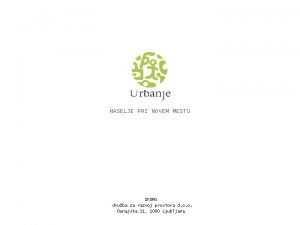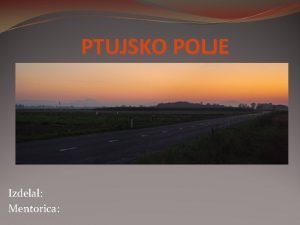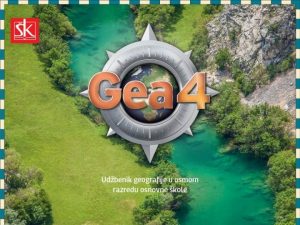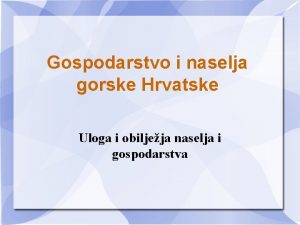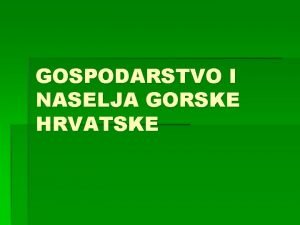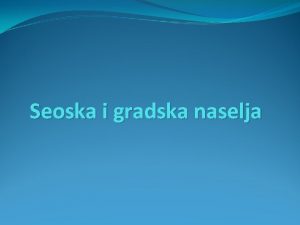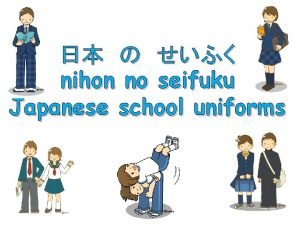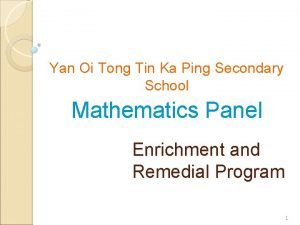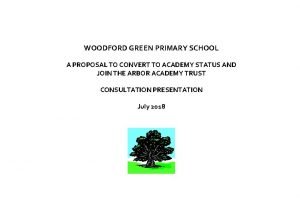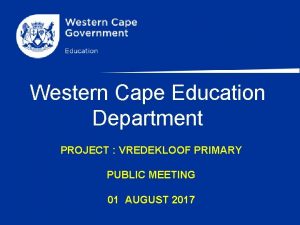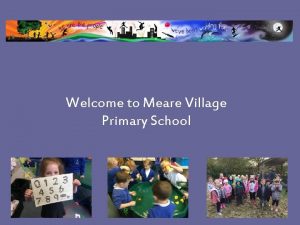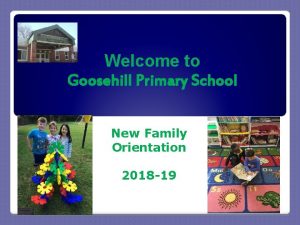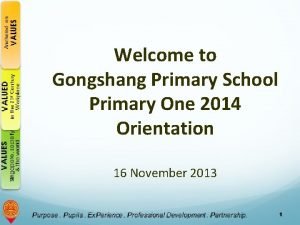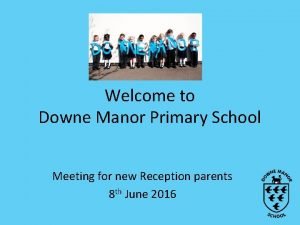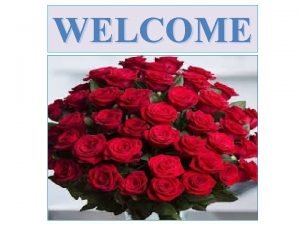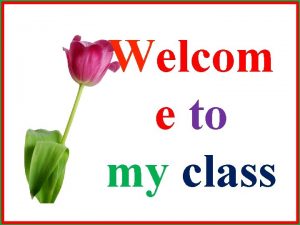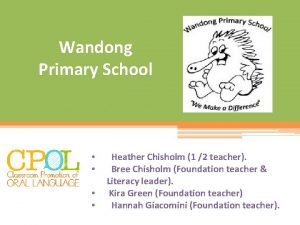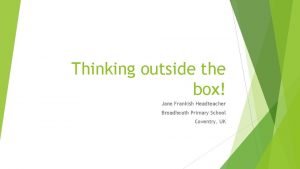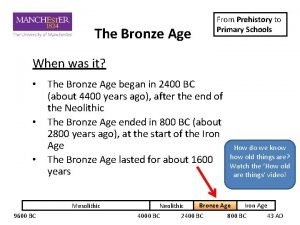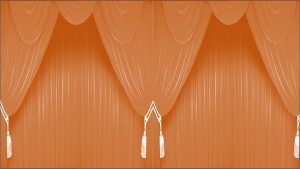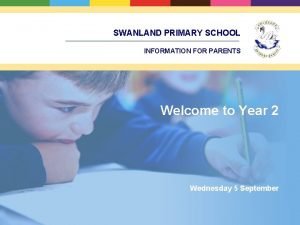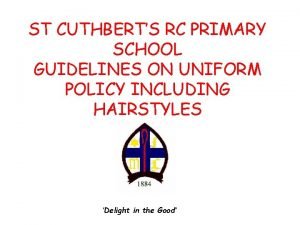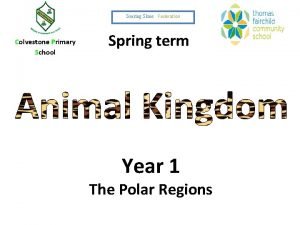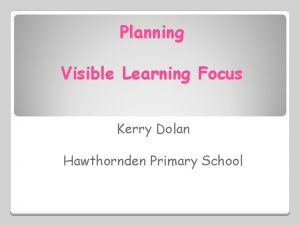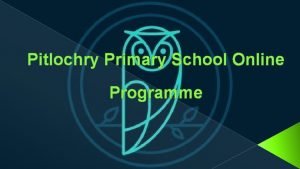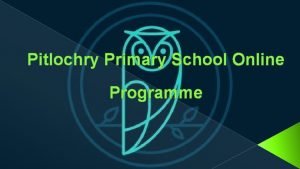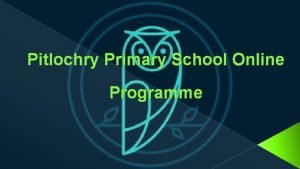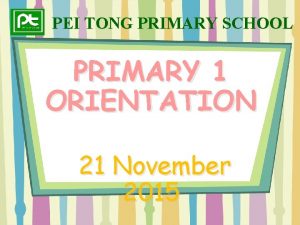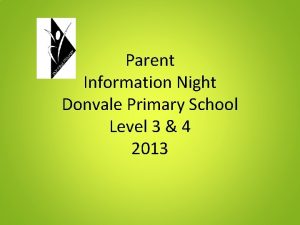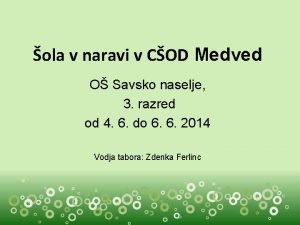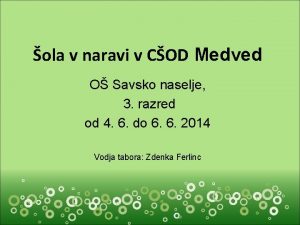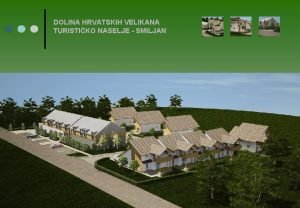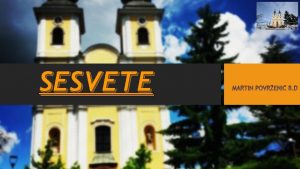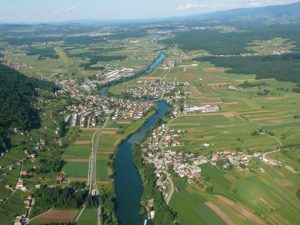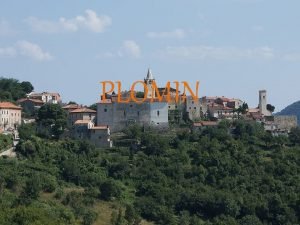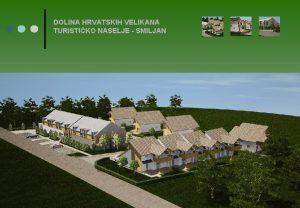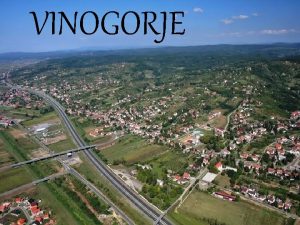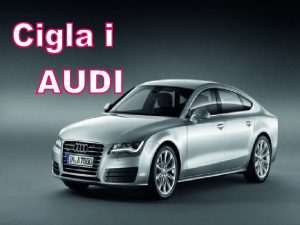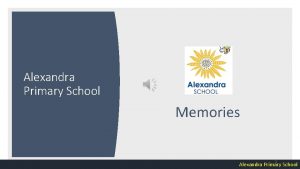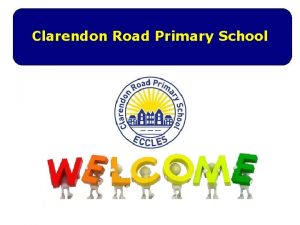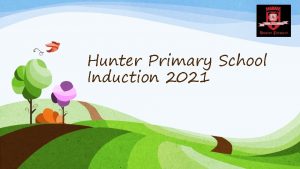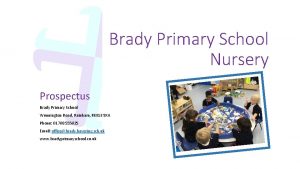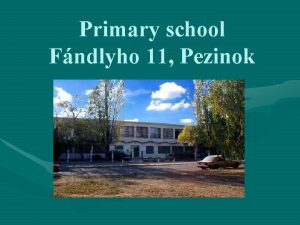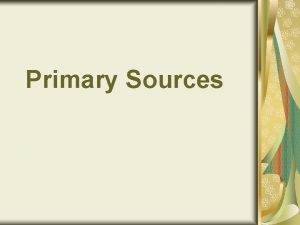Primary School Savsko naselje Primary School Savsko naselje































- Slides: 31

Primary School Savsko naselje

Primary School Savsko naselje is one of 47 schools in Ljubljana, the capital of Slovenia. The school is located in Ljubljana, the capital of Slovenia. It is situated in the centre of a housing settlement called Savsko naselje. The settlement itself is located approximately 20 minutes form the city centre if you go on foot, or approximately 10 minutes by car or bus.

Brief History • The school started being built in the Spring of 1957. It opened its doors to first pupils on 1 st of October, 1958. There were 291 pupils in grades 1 -8, and school lasted from Monday to Saturday. Works on school continued so the official opening was on 23 rd of May 1959. The school was named Boris Kidrič Primary School.

• Throughout the following years the school continued to grow – extensions were built to provide space for a kindergarten, a library, a staff room, a dining room with a kitchen, a small and a big gym, a swimming pool, playgrounds, as well as some additional classrooms.

• The school changed its name into Primary School Savsko naselje in the Autumn of 1997. Today, it is a medium-sized, state-owned school with approximately 300 pupils in grades 1 -9, and a staff of 40.

School year • School starts on 1 st September and ends on 24 th June which means Summer holidays last about 10 weeks. • During the school year pupils also have 4 other holidays: - ‘’potato’’ holidays (last week of October/first days of November) - Christmas holidays (from around 25 th December until around 1 st January) - Winter holidays (one week in February) - May holidays (from around 27 th April until 2 nd May).

National Assessment of Knowledge (NAK) • At the end of 6 th and 9 th grades pupils take a National Assessment of Knowledge (NAK). All pupils in Slovenia take the same test on the same day at the same time. • In 6 th grade they take the test in their mother tongue (Slovene, Italian, Hungarian), Maths and a foreign language (English or German). • In 9 th grade they take the test in their mother tongue (Slovene, Italian, Hungarian), Maths and another subject.

Marks • The marks in primary school start with 1 (insufficient) and it is the only failure mark. The second one is 2 (sufficient), the next is 3 (good), then 4 (very good) and the best is 5 (excellent). • At faculty, marks are from 1 -10, 6 means that a student has passed the exam.

A typical day at our school • Children start going to school at the age of 6. Primary school lasts 9 years. • Lessons start at 8. 20. Each lessons lasts 45 minutes, then there is a 5 minute break. Pupils in grades 1 -5 stay in the same classroom the whole day, while pupils from grades 6 -9 change classrooms. • Pupils have a morning snack from 9. 55 to 10. 15. Pupils in grades 1 -5 eat in their classrooms, while pupils in grades 6 -9 eat in the school canteen. • A typical snack is bread and a spread. They also get something to drink (tea, milk, cocoa, juice). If pupils don’t like the school snack, they can bring their own.

• Lunch starts at 11. 50 and the canteen is open until 1. 45 p. m. Pupils have lunch after their last lesson. • Lunch is cooked by another school and is brought to our school. It is served hot. • After school, pupils can have extra curricular activities. • Pupils from grades 6 -9 go home after their last lesson, while pupils from grades 1 -5 can stay at school until 5 p. m.

What can you find at our school? • Classrooms: Grades from 1 -5 have their own classrooms – each classroom is equipped with its own PC and internet access. Grades 6 -9 have a home classroom, but they change classrooms for individual subjects. Each classroom has a PC with internet access, and a projector.

• Research & reading: Our library and reading room has around 10, 000 books. There also computers with internet connection where pupils can research topics that interest them or that are related to school projects.

• Science, Information Technology, Craft Classrooms: The school has two Science classrooms, a Computer classroom, and a Crafts classroom. Computer facilities include a 30 -workstation computer laboratory with internet connection. Three classrooms also have an interactive board.

• Dedicated classrooms: There also dedicated classrooms for language learning (English/German/Slovene/Spanish), Social Studies (Geography/History), Music, Art and Home Economics.

• Sport: Pupils can do sports in two gymnasiums, an indoor swimming pool, and an outdoor all-weather playing area.

• Kitchen and the canteen: We provide breakfast, mid-morning and mid-afternoon snacks, as well serving hot lunchtime meals. Breakfast and mid-afternoon snacks are only available to pupils from grades 1 -5 who are part of the morning and/or afternoon care.

• Extra-curricular activities: An interesting programme of extra-curricular activities is offered at the beginning of each school year. Activities take place in the afternoon. Most are available at no extra cost, and they run until the end of May.

Projects • Each year we do projects on school level, city level, state level and international level.


• Every year we have a contest Create an Original Christmas Tree, in which pupils (and their parents) create Christmas trees from recycled materials of their choice. At the end of the competition we organise an auction at our Christmas bazaar; the money we raise goes into the school fund and is spent on providing school material for less-privileged pupils.

• Thirty of the most diligent readers are invited to our Night of Stories at the Library. It is a night full of activities – from playing in the swimming pool, participating in workshops, eating pancakes, to reading stories late into the night. It definitely is a night they remember for a long time.

• Pupils with a desire to perform are also able to try their hands at it. They can join the school choir, or if their forte is acting, they can take part in the school’s theatre club. They usually perform at various school receptions and celebrations, as well as on cultural marathon day which we have at our school.

• Every year, pupils from grades 5 -7 go on a winter camp.

• Gifted students from grades 5 -9 go on a summer camp at the end of the school year.

• Pupils also take care of our small garden.

• In the school year 2012/2013 we also created our own project called Diversity enriches us. Pupils at our school come from different cultures and nationalities, and we wanted to include all of them in this project, thus showing everyone that we are all the same. The pupils learnt a dance, and then performed it in flashmob style in the city centre: http: //www. youtube. com/watch? v=-f. Zd 2 n 3 z. KD 0

Pupils from the 7 th grade also helped develop the architectural plan for a basketball court, the hill and the playground in their settlement.

• Our school was also chosen to organise a cultural performance in honour of Chinese New Year on 8 th of February, 2016. Our pupils performed a play based on the book Ferdinand Avguštin Hallerstein – A Slovenian in the Forbidden City by Huiqin Wang. • The scenery and the costumes were all made by teachers of our school. • You can see the whole performance, including the opening speeches here: http: //videolectures. net/osnovne_os_savsko_naselje_k itajsko_leto/

• At the end of primary school pupils have a junior prom that they organise themselves. It takes place at our school.

After primary school • All children in Slovenia have to go to primary school (it is compulsory). • After primary school, pupils go to secondary schools. Most are vocational or technical and they last 2 -5 years. Pupils can start working after graduation. • Some secondary schools are general (we call them ‘gimnazija’) and usually only the best pupils enrol in them. They last 4 years. • At the end of secondary school they write ‘matura’ (exam in 5 school subjects) and the score determines what faculties they can go to.

• After secondary school they can study at a faculty. • Public primary and secondary schools in Slovenia are free (there is no tuition) – parents only pay for workbooks, notebooks, pencils, pens, etc. • There is also no tuition at faculties – students have to pay for textbooks and other material. • Some faculties also offer places for people who already work. Lessons usually take place on Friday afternoon and Saturday morning and such students have to pay a tuition fee.
 Naselje pri novem mestu
Naselje pri novem mestu Ptujsko polje
Ptujsko polje Naselja gorske hrvatske
Naselja gorske hrvatske Bjelolasica
Bjelolasica Drvna industrija u gorskoj hrvatskoj
Drvna industrija u gorskoj hrvatskoj Tipovi gradskih naselja
Tipovi gradskih naselja Traditional japanese school uniform
Traditional japanese school uniform Yellow magenta and cyan are the ___
Yellow magenta and cyan are the ___ Yan oi tong tin ka ping primary school
Yan oi tong tin ka ping primary school Yiu tupe
Yiu tupe Meed wced
Meed wced Meare village primary school
Meare village primary school Goosehill primary school
Goosehill primary school Poh qinyu principal
Poh qinyu principal Downe manor primary school term dates
Downe manor primary school term dates This is mahbub alam class 3
This is mahbub alam class 3 Welcom
Welcom Bree chisholm
Bree chisholm Jane frankish
Jane frankish Bronze age technology
Bronze age technology A e i o u a i
A e i o u a i Farzana and jamil are from kushtia bangla meaning
Farzana and jamil are from kushtia bangla meaning Swanland primary school
Swanland primary school St cuthberts primary school uniform
St cuthberts primary school uniform Soaring skies federation
Soaring skies federation Psle results 2013
Psle results 2013 Hawthornden primary school
Hawthornden primary school Pitlochry primary school online programme
Pitlochry primary school online programme Pitlochry primary school
Pitlochry primary school Cell phone tower project grade 7
Cell phone tower project grade 7 Pei tong primary
Pei tong primary Donvale primary school
Donvale primary school
